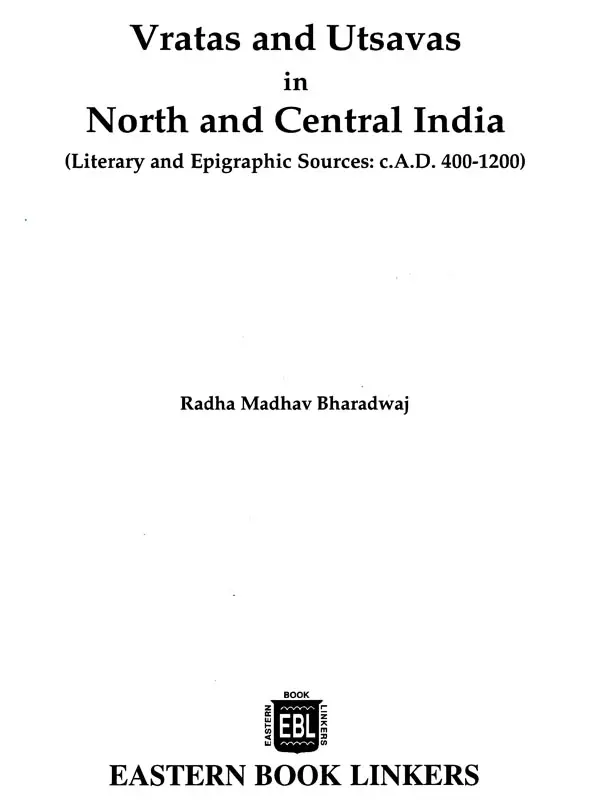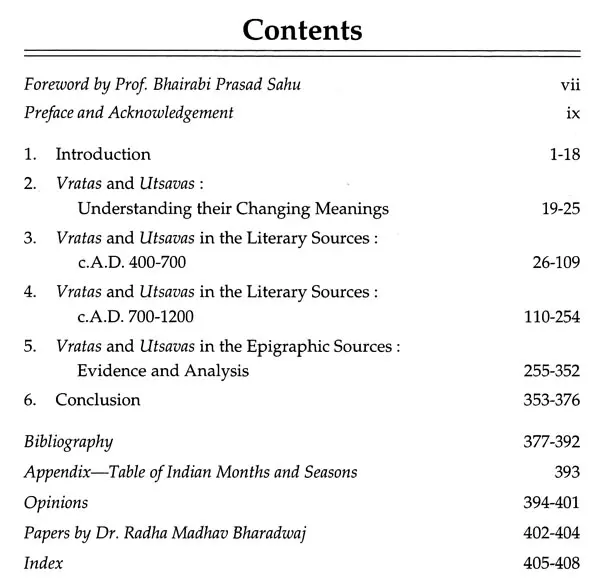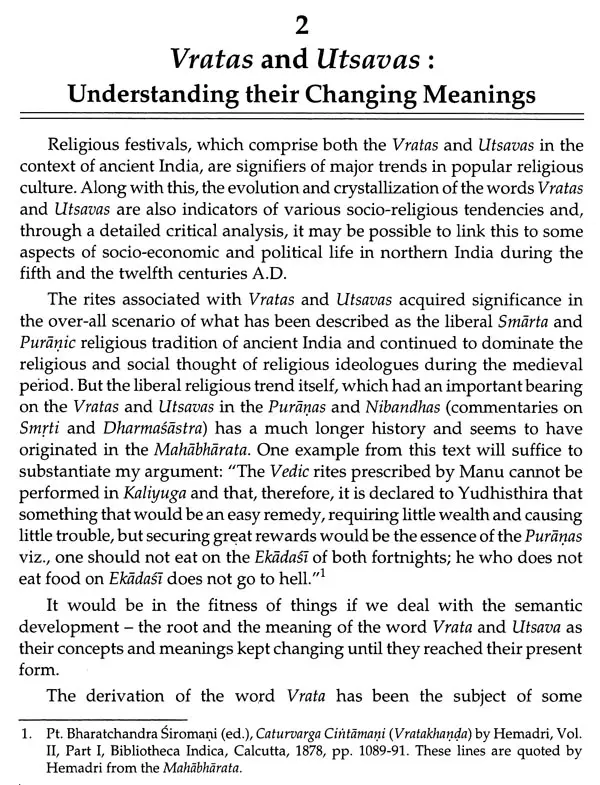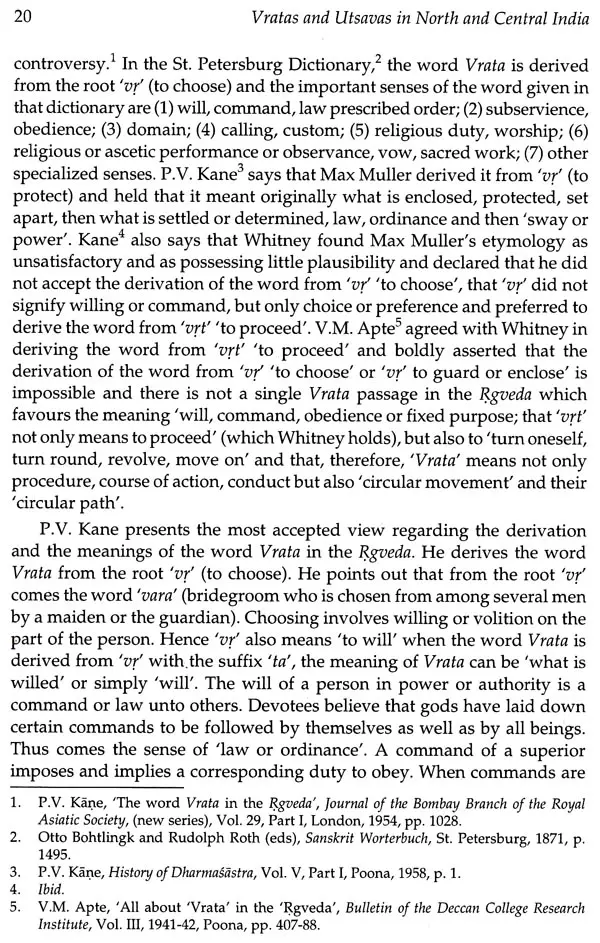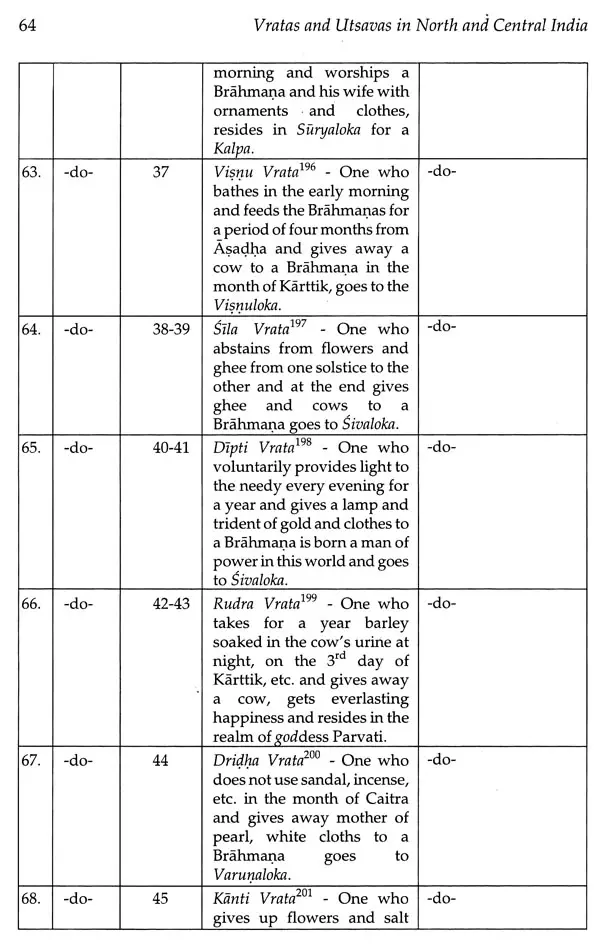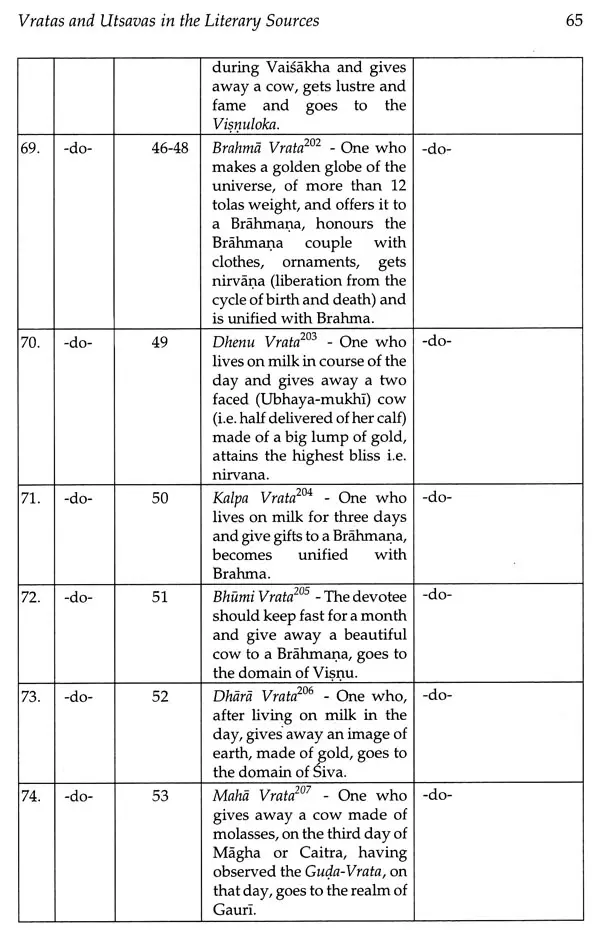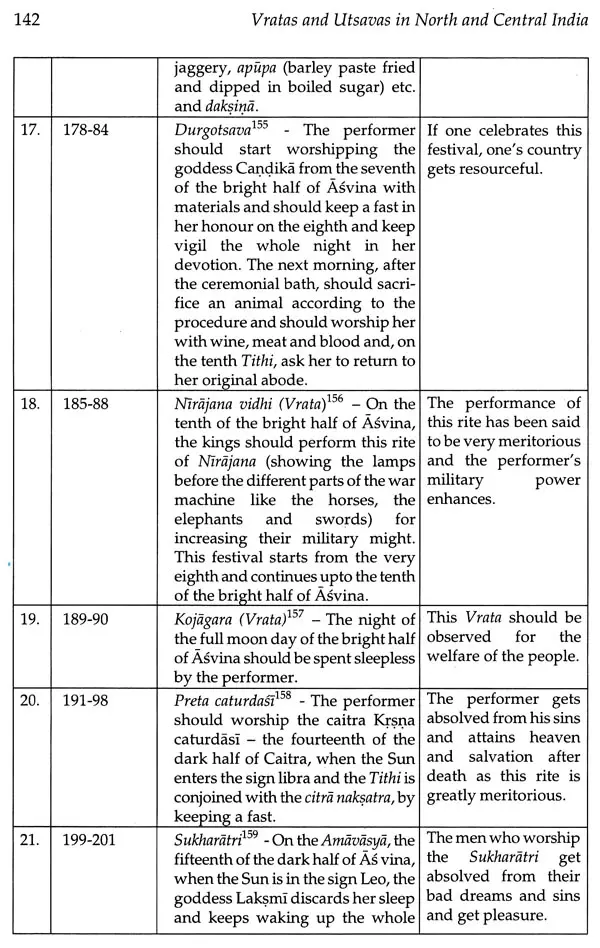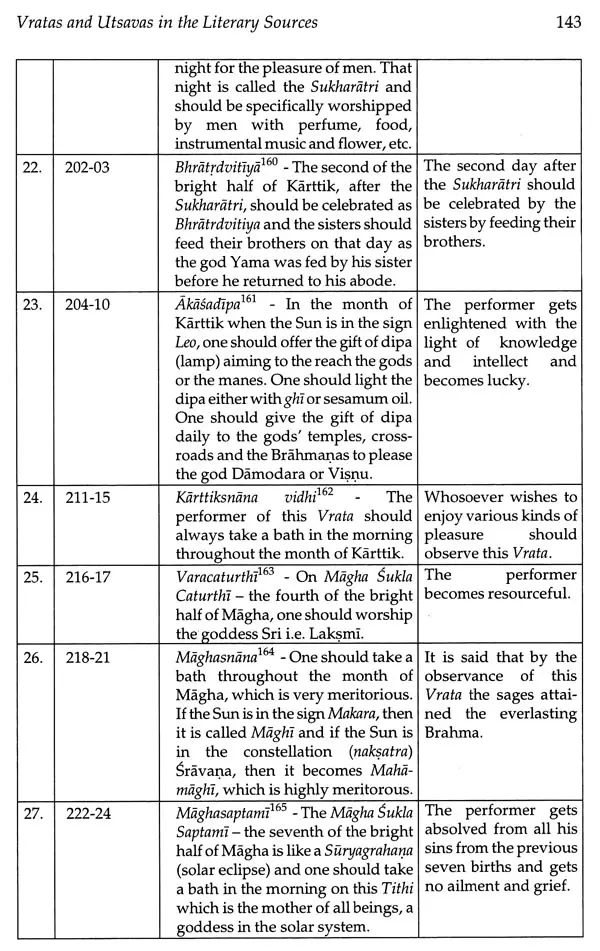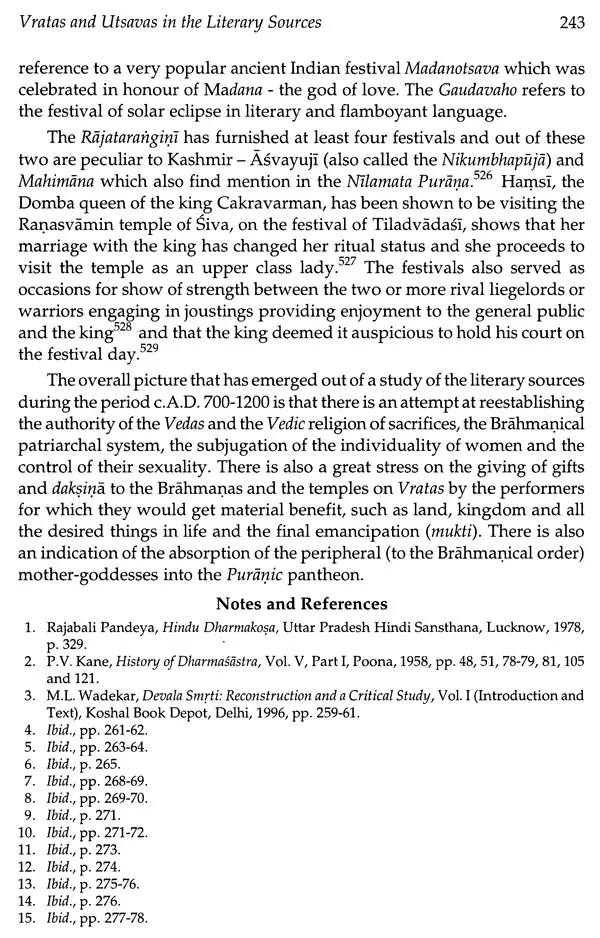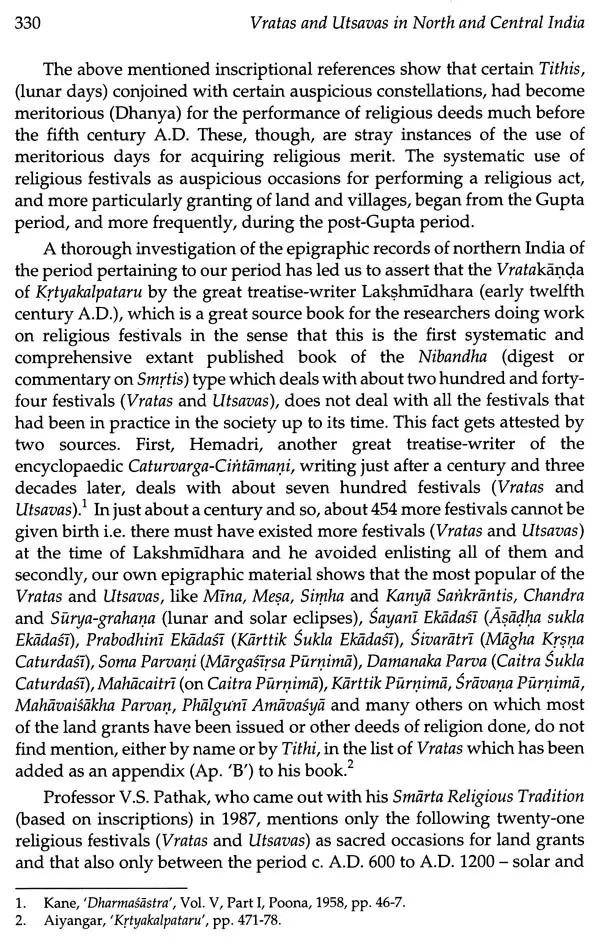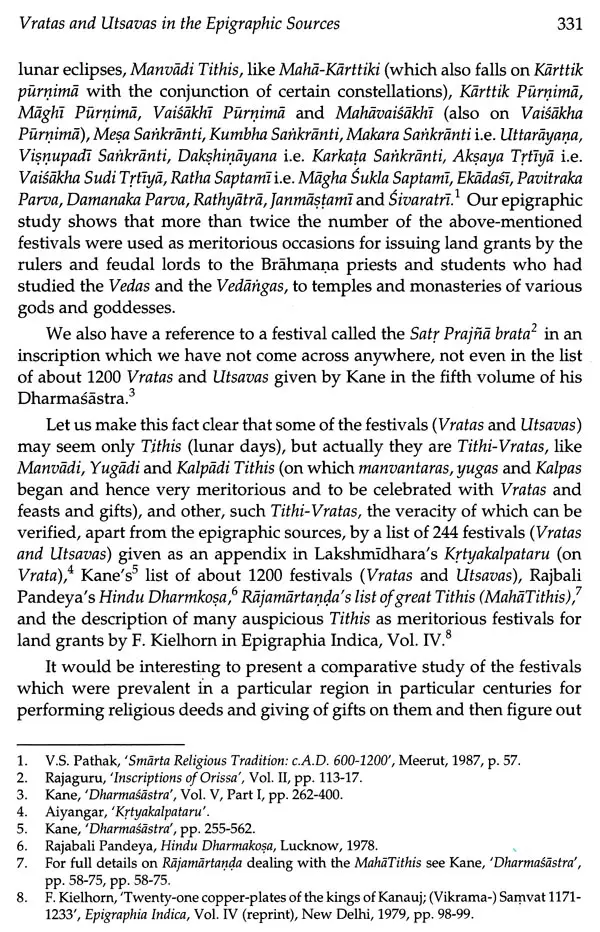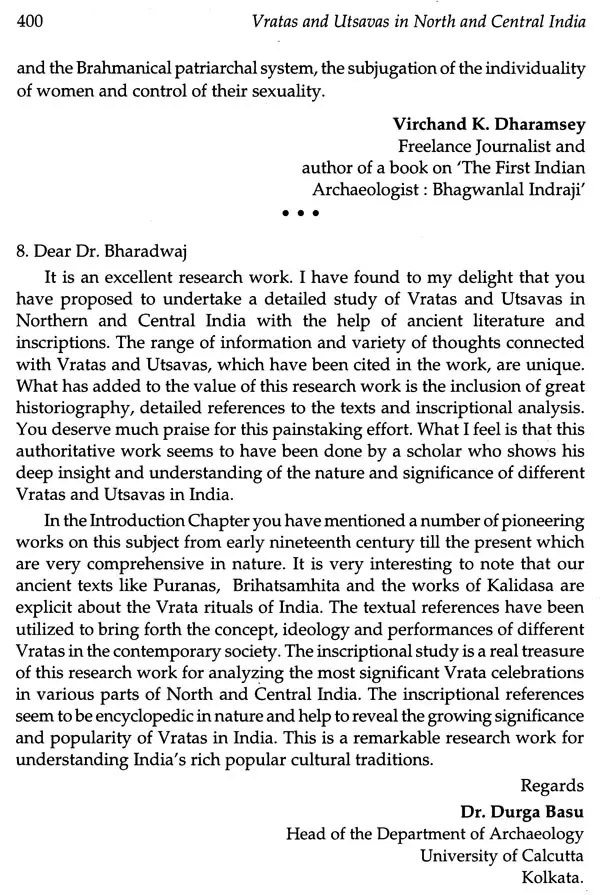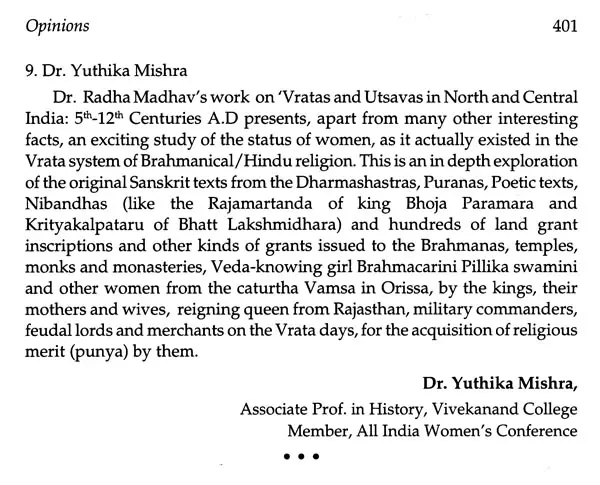
Vratas and Utsavas in North and Central India (Literary and Epigraphic Sources: C.A.D. 400-1200)
Book Specification
| Item Code: | UAI108 |
| Author: | Radha Madhav Bharadwaj |
| Publisher: | Eastern Book Linkers |
| Language: | English |
| Edition: | 2015 |
| ISBN: | 9788178542805 |
| Pages: | 416 |
| Cover: | HARDCOVER |
| Other Details | 10.00 X 7.50 inch |
| Weight | 970 gm |
Book Description
Ancient Indian religious systems between the 5 and 12 centuries A D in North and Central India have been attempted to be and analyzed through the Dharmastric institution of Vratas (religious) vows), the most vibrant form of religion amongst the Hindus today, with the help of the Vedic, Dharmasastric, Puranic and Poetic texts and Inscriptions belonging to the period c. A.D. 400-1200.
The number of Vratas and Utsaras are increasing and so are the verses dealing with them in the literary texts. The religious ideologues guaranteed expiation of sin and attainment of worldly (bhukti) and final emancipation (mukti) for their performers and reestablishment of the authority of the Vedas, the Vedic religious institution of sacrifices, Brahmanical patriarchy and subjugation and control of the sexuality of women for themselves. There is found great exhortation for giving of Daksina (priestly fees) and Dana (gifts) to the priestly class of Brahmanas, temples, monasteries and which finds enthusiastic response from the rulers and their officers, feudal lords, rich merchants and royal women of the time who issued a large number of grants of plots of land, villages, orchards, and other valuable things, with legal and administrative rights, to the Brahmanas, temples and their Brahmana custodians. and Buddhist and Jain monks, on meritorious Vrata occasions. This led to the expansion of the Brămanical culture into the peripheral and tribal regions, confrontations with the local tribal population and related incidents of Brahmahatya (Brahmana-murder about which we have recurrent apprehensive references), absorption of the tribal mother goddesses into the Puranic pantheon and seemingly also to the feudalization of the politico-economic structure of North and Central India from the fifth century A.D. onwards to a great extent.
Dr. Radha Madhav Bharadwaj did graduation and post-graduation from Hindu college, University of Delhi and M.Phil. and Ph.D. from the same University An Indian Council of Historical Research (ICHR) fellow (1990 91), has taught Undergraduate and Post graduate classes of the University of Delhi since 1989. Read Papers at National and International conferences within and outside India. His visits to foreign Universities and countries include Mahidol University, Thailand (2007), and Pnom Penh and Angkor Vat in Combodia; Universities Hindu Indonesia (UNHI), Denpasar, Bali, Indonesia (2009), Borobudur and Prambanam Temple world heritage sites, Yogyakarta, Jawa, Indonesia and University of Toronto, Canada (2010). About 12 of the papers have been published in Refereed International and National journals and books. He has been twice member of the faculty of Social Sciences, University of Delhi (1996-99; 2010-2013). Delivered lectures at 1000 year old Nohaleshwar Kalchuri temple, Damoh (Feb. 2001), Delhi School of Economics, (Feb. 2007), National Mission for Manuscripts, Ministry of Culture, Govt. of India (2008), Deptt. of History, University of Delhi, (2008), Nehru Memorial Museum and Library, Teen Murti, (20 December 2011), 95 Numismatic Society of India, Santiniketan, west Bengal, (2012). Presently he is an Associate Professor in History at D.D.U. College, University of Delhi. Has been recently nominated Member, Society Asiatique, Paris, June, 2014.
The present thesis is an attempt at examining the emergence, nature and role of Vrata and Utsavas in the religious and social life of north and central India between the fifth and the twelfth centuries A.D. The historiography of religion during this period deals mainly with the most obvious forms of religion, like Saivism, Säktism, Tantrism, Vaisnavism, Buddhism, Jainism and others but the institution of Vratas and Utsavas has not drawn any serious attention in the modern writings of the period. An indepth literary and inscriptional inquiry of the subject makes it amply clear that the Brahmanical religion of Vratas and Utsatas emerged as a very powerful institution and played a significant role in the religious, social, material and political life of the people of north and central India between the fifth and the twelfth centuries A.D. The thesis, therefore, is a humble. attempt at addressing a gap in the historiographical reconstruction of socio religious and political systems during the staid period and to bring before the academic community the significance of the study of this institution. The thesis in its existing form could become possible mainly because of my supervisor, Professor Nayanjot Lahiri. No words would be adequate enough in expressing her role in giving shape to my ideas. I thank her from the depth of my heart for painstaking guidance, meticulous discipline and constant encouragement. She has been kind enough to spare some of her most valuable time in going through my drafts again and again. I also thank Professor Pratipal Bhatia with whom I have had the privilege of working as a research scholar for quite a long time.
I would like to thank Professors D.N. Jha, B.D. Chattopadhyaya, T.K. Venkatasubramanian, K.M. Shrimali, D.K. Chakrabarti, B.P Sahu, Kumkum Roy, R.C. Thakran, V.K. Thakur and Drs. Biswamoy Pati, R.K. Chatto padhyaya and Gautam Sengupta who inspired and helped form some of the ideas with their constructive criticisms in my meetings with them at various seminars and academic for a over the years.
The treatise Vratas and Utsavas in North and Central India is a welcome addition to the growing volume of literature on early medieval India. It examines the role of tratas and utsavas, and their changing histories, in everyday life during the said period. This is an important work insofar as it contributes to our understanding of facets of socio-religious life during the times, by focusing on an area which remained largely neglected owing to the historians' preoccupation with the visibly dominant forms of religion. The reliance on the combined testimony of literature and inscriptions renders it qualitative richness, together with the built-in advantage of a comparative perspective. While the puranas reveal the details of the rituals, their performance and associated advantages, the inscriptions provide evidence for their spatial spread across time. The latter source, with its more accurate information, allows for the tabular representation of the data across centuries, making it possible to engage in wider correlations. The social base of the donors and donees, including women, monks and monasteries, comes alive. It also sheds light on their role in sustaining Brahmanical ideology and its inextricable constituents like patriarchy. The gradual expansion in the orbit of these practices, together with the associated ideas, and the integration of the sudras, through these mechanisms, with general society has been treated coherently.
The merit of the work lies in the fact that it tells us not only what utsavs and utsavas were or how they were performed, but also when and where they were played out; with all their social implications. This should be of interest to both the serious and informed general reader of early Indian history.
(i) A Brief Survey of Modern Writings on Festivals (Vratas and Utsavas)
The purpose of this chapter is to survey some modern writings on Vratas and Utsavas in ancient north and central India. It is not as if every secondary writing on this theme has been mentioned or even examined but hopefully, no major publication has been ignored in this survey.
Perhaps one of the earliest modern explorations of religious festivals in ancient north India was presented in the Asiatic Society of Bengal by Sir William Jones who also published a paper on this theme in the third volume of the Asiatic Researches Jones' article was based on the Tithitattva of Raghunandana, the most celebrated treatise writer of Bengal during the early sixteenth century A.D Jones, however, took from this work only the heads of the descriptions along with a few brief notes and his details are neither sufficiently full nor interesting to inspire others Jones, however, remarked that although most of the Indian fasts and festivals are regulated by the lunar days, the most solemn and remarkable of them have a manifest reference to the supposed motions of the sun. In 1846, one of the lectures of Professor HH. Wilson entitled The religious festivals of the Hindus was published in the Journal of Royal Asiatic Society of Bengal. It was later published in the Essays and Lectures on the Religions of the Hindus In all, he briefly discussed about eighteen festivals and also quoted sources such as Padma Purana, Bhavisyottara, Tithitattva, Nirnayasindhu, Sabdakalpadruma, Garuda Purana and Bhagavata Purana albeit very casually? Moreover, his observations were limited to Bengal only and that also with regard to the festivals of only two months-Magha and Phålguna. These essentially were brief sketches of the vast and significant topic of festivals (Vratas and Utasavs) and they mentioned just the names of some festivals, their months and the time of their celebration, hardly taking any pains in describing the procedure of their performance and delving deep into the original sources for presenting their views with much authenticity.
In 1885, E.W. Hopkins' Religions of India was published from Boston. It contained a hastily written sketch on the six religious festivals of the Hindus in a few pages drawing information solely from Wilson. In 1917, C.H. Buck published his book Faiths, Fairs and Festivals of India. In all, he discussed about twenty festivals according to Indian months drawing most of his information from eastern Punjab and western India. Although he hardly quoted any source book, he has mentioned some now obsolete festivals like the Pethuri or Pracha Amavasya in honour of the sixty-four yoginis, or female attendants of the goddess Durga, Champa Sasthi in honour of a local god of western India on the occasion of which the human hook-swinging ceremony used to take place and the festival of Koli Diali in honour of a local goddess Hirmă of Kulu, obviously a non-Vedic non-Puranic tribal deity, for protection from the snakes. With a view to attempting to write a total history of Vratas and Utsavas, we have taken the help of the data from the British District Gazetteers of the late nineteenth and the early twentieth centuries.
With a view to governing their Indian empire better, the British needed sources to understand Indian traditions and culture better and hence some of the British officers delved deep into exploring the traditional cultural beliefs and practices of India. In this endeavour they came out with rich and rare facts on the religious festivals of India. These often make us wonder if their magnificent works were meant to serve administrative purposes only.
Although lacking in analytical details, a perusal of the data regarding festivals and fairs of the Hindus as recorded in the various district gazetteers of north and central India were important as they represented the first collection of Hindu festivals and fairs which were in actual practice in different parts of northern and central India in the late nineteenth and the beginning of the twentieth century. Being in the form of field data, they had an anthropological and ethnic touch in their treatment and presentation.
The Gazetteer records described the festivals and fairs of the Hindus as mixture of various traditions - Vedic, Smärta, Puranic Tantric, as also local and animistic, of the Hinduised and semi-Hinduised population. They were shown as having acted and interacted upon each other and presented an integrated picture of Hindu festivals and fairs. An analysis of them revealed that there has been a conscious attempt on the part of political elites to patronize and encourage the festivals and fairs of the major tradition which best suited their interests and they seem to have absorbed, gradually, a great number of minor tradition festivals and fairs, cults and deities in their fold, in various parts of northern and central India. However, at the same time, the festivals and fairs of the traditions of the Hinduised tribals and the aboriginal people, still maintained their local character despite the process of integration and absorption.
**Contents and Sample Pages**
